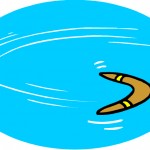 For many, Woody Allen’s “Midnight in Paris” film will be about romance and comedy. But for me, this film was about boomerangs and frisbees.
For many, Woody Allen’s “Midnight in Paris” film will be about romance and comedy. But for me, this film was about boomerangs and frisbees.
Boomerangs and frisbees? I know, this seems very odd. Bear with me.
The main character in this film, Gil (played by Owen Wilson), is visiting Paris, France with his fiancé Ines (played by Rachel McAdams) and her parents. Gil is a writer who is attempting his first novel. While he walks the streets of Paris for inspiration each evening, his wife is otherwise engaged with more traditional sightseeing and other distractions. One evening, Gil stumbles into the Parisian 1920s, his favorite time period. He is so inspired by the genius of this period of time, he returns to the 1920s each evening, seeking more.
But what is his search really about?
Like so many who sojourn, we travel to learn about other ways of life, history, people, and language. What we often don’t realize is that by leaving home, we have the ability to see “the self” in a very different light. As an international educator, “Midnight in Paris” was much less about Woody Allen’s quirky humor and much more about Gil’s exploration of the “shift in self” that often happens when we study, live and travel abroad.
This film raised this question for me: Why do some see study abroad in terms of what I’ll call the “boomerang effect?” (By this, I do not mean these definitions related to social psychology and marketing. Melibee Global’s version of the boomerang effect is not surprisingly related to study abroad.) The boomerang effect describes students who typically go abroad and in most cases, loop back to their country of origin.
What drives some to return to the safety net of home after a period of time abroad while others study abroad and then never want to return to what they’ve known as “home” for decades? For those who defy the boomerang effect, home begins to feels more normal abroad. Abroad is now the new norm, requiring one to relocate, or to attempt to do so.
Ironically, the boomerang was often used in hunting. Today, perhaps the boomerang is a metaphor for crossing cultures. One is sent airborne to see a bird’s eye view of another place and its people. And in most cases, one returns to the point of origin and shares that 30,000 foot view with friends, family and neighbors.
Over the years, I have met many international students who have come to the US and planned to return home, yet found themselves pursuing multiple degrees to remain in status so that they do not have to depart the country. I’ve also met a handful of US study abroad students who have also needed to create their home abroad. Perhaps this can be called the “frisbee effect.” You toss a frisbee, it lands somewhere and it does not fly (depart) again unless someone throws it (or forces it from its place.)
Needless to say, I thought I’d be seeing a typical Woody Allen film, having a good laugh and moving on. It sparked all these ideas between the humor, wisdom and great acting. I would definitely recommend that you share Allen’s “Midnight in Paris” with your students. It is a really playful tool for creating dialogue about Americans abroad and both the “boomerang”/”frisbee” effects.
